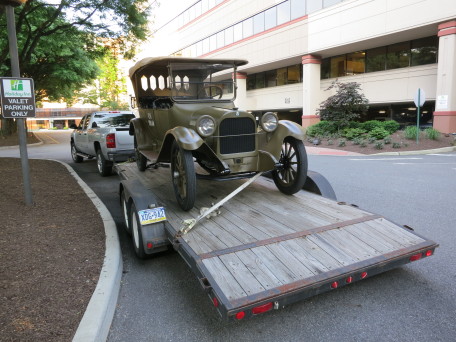SECAUCUS, New Jersey, is not on the Lincoln Highway. The original Lincoln Highway, the first transcontinental road in the United States, ran along 42nd Street in Manhattan, across the Hudson River by ferry to Weehawken, New Jersey, then south to Philadelphia and points west. The Lincoln Highway Association (LHA) chose the Holiday Inn Meadowlands in Secaucus to kick off its centennial tour because Holiday Inn was a sponsor and because, in the words of one member, “There are Holiday Inns all along the Lincoln Highway.”
The LHA was responsible for getting the road built, beginning in 1913. To celebrate the highway’s 100th birthday, the association sponsored a drive across its entire length in June 2013. They expected 270 people, 140 vehicles, and participants from as far away as Australia, Norway and Russia. The tour had two parts, one beginning in San Francisco (the highway’s western terminus) and an eastern contingent leaving from New York. The two tours met in Kearney, Nebraska, roughly halfway across the country.

The Lincoln Highway Association centennial celebration pre-tour dinner at the Holiday Inn Meadowlands, Secaucus, New Jersey.
The Holiday Inn Meadowlands lacked every conceivable charm that could be conjured by the image of a tour across America’s oldest highway. Set among a panoply of malls, parking lots, chain stores, and new asphalt sealant, the Holiday Inn was large and clean. The lobby contained a water feature, a bar and a Starbucks. The LHA dinner was upstairs in the Essex Room, a small fluorescent-lit banquet hall. Inside were about a hundred middle aged to elderly men and women. A buffet was at one end of the room and a kind of gift shop and registration center at the other.
Upon closer inspection this shop proved to be the Lincoln Highway Trading Post: Postcards 50 cents, bandanas $9.95, stickers $1, patches $3. Manning the trading post was Brian Cassler from Canton, Ohio, high school student, and by far the youngest person in the room. Brian was spending his summer vacation on the tour with his father, Jim Cassler, a commercial printer and the tour organizer. Jim was also a Civil War re-enactor and would be performing for the tour when it got to Gettysburg.
“People used to get on the roads to have a good time, not make good time,” said Tim Wunsch, in town from Fort Morgan, Colorado, with his wife, Judy. He was signing up drivers and handing out packets and badges. Judy said they got interested in the highway when Tim accidentally attended a seminar on it at a local museum. A truck mechanic and welder by trade, Tim drives the “sweep vehicle,” whose job was to pick up people whose cars had broken down. For him the LHA was an important social network. That’s how he met Jim Cassler, who has become a good friend. Judy Wunsch said that most people in the association are retired and have a personal relationship with the road. She drives along it all the time in Colorado. Almost no one in the room seemed to be from New York.
Kay Shelton was late to dinner because her cabdriver couldn’t find the Holiday Inn. A brisk and efficient woman, perhaps the youngest in the room after Brian Cassler, Shelton had flown in that afternoon. She teaches geography at a community college outside of Chicago. The Lincoln Highway runs by her school. As LHA president, she was flying to San Francisco the following morning at 9 a.m. to see off the western leg of the tour.
Talking into a bullhorn in the middle of the room was Jim Peters, PR man for the LHA. As caravan participants bent over cold-cut sandwiches and pasta salad, Peters detailed every dusty particular of the route.
Outside, in the balmy air of early summer, about two dozen classic cars were parked in the Holiday Inn’s massive garage. The cars would make the trip to Kearney, and a few stray guests took pictures. Valet parked on a flatbed was a 1918 Dodge Brothers Army Staff Touring Car. According to Jim Cassler, Dwight D. Eisenhower had driven something similar when he traveled the Lincoln Highway with the U.S. Army in 1919. Cassler says it took Ike so long, 62 days, that he realized the need for a more efficient road network. This led to the creation of Eisenhower’s Interstate Highway System—the bigger, faster network of roads that ultimately rendered much of the Lincoln Highway obsolete.

